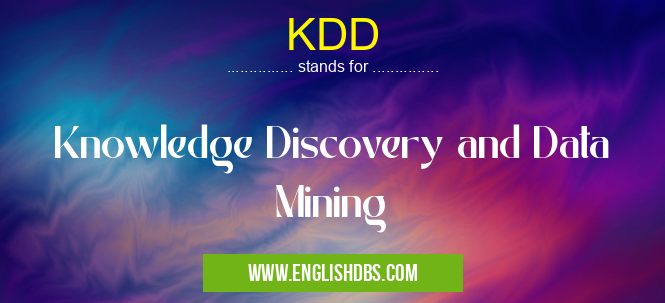What does KDD mean in SOFTWARE
Knowledge Discovery and Data Mining (KDD) is a process of extracting useful information from a large quantity of raw data. It involves the use of sophisticated software tools to analyze and interpret data to detect patterns, correlations, and trends. KDD focuses on discovering unknown knowledge from these mined results by applying algorithms, statistical methods, and machine learning techniques. In addition, KDD seeks to understand the structure of the data, uncover meaningful relationships between variables, and gain insight into how the data can be used for decision-making processes. By combining these analysis techniques with intelligent systems like artificial intelligence (AI) and natural language processing (NLP), KDD can be used to extract useful knowledge from data that would otherwise remain buried in unstructured datasets.

KDD meaning in Software in Computing
KDD mostly used in an acronym Software in Category Computing that means Knowledge Discovery and Data Mining
Shorthand: KDD,
Full Form: Knowledge Discovery and Data Mining
For more information of "Knowledge Discovery and Data Mining", see the section below.
What does KDD Stand for?
KDD stands for Knowledge Discovery and Data Mining. It is an innovative approach to leveraging raw data for exploration and finding hidden patterns within it, which typically lead to insights that help organizations improve their products and services. The process begins by understanding what types of information are needed in order to make decisions or take actions based on those findings. Data mining is then used to identify known patterns as well as potential correlations among the variables in the dataset before any assumptions about these correlations can be made. Finally, intelligent techniques such as machine learning are applied to determine if any meaningful insights can be derived from these patterns or correlations.
Essential Questions and Answers on Knowledge Discovery and Data Mining in "COMPUTING»SOFTWARE"
What is Knowledge Discovery and Data Mining?
Knowledge Discovery and Data Mining (KDD) is a process of finding useful, previously unknown, and potentially valuable patterns in large collections of data. It involves the application of algorithms to detect relationships or patterns that may exist between different types of data. KDD also includes techniques to verify the discovered knowledge and refine it into useful information or knowledge for decision making.
What are the stages of KDD?
The stages of Knowledge Discovery and Data Mining generally include selection, preprocessing, transformation, data mining, visualization, and interpretation. Selection involves choosing which type or subset of data will be mined. After selection the preprocessing stage consists of cleaning up the raw data so it can be more efficiently used in subsequent stages. Transformation follows this step where unstructured data is translated into a structured format usable by the algorithms. After transformation comes the data mining stage which applies various algorithms to find significant patterns in the data. Following this is visualization which helps create graphical representations of these potential relationships for further analysis. Lastly Interpretation which focuses on verifying or rejecting any inferred results found during mining as being true or false based on real-world validation.
Why is KDD important?
Knowledge Discovery and Data Mining is an important tool in today's world where vast amounts of information is available at our fingertips. By employing KDD tools businesses can gain valuable insight from their collected data to make better decisions about their product offerings, marketing strategies, customer service approaches etc., providing them with an advantage over competitors who lack such insights from their own datasets. Additionally KDD techniques can be used to uncover hidden trends within large sized datasets that would otherwise go unnoticed without such specialized analytical techniques employed against it allowing analysts to understand unseen phenomena and make better decisions utilizing those newfound insights.
What are the types of data mining tasks?
Generally speaking there are four main types of tasks when it comes to applying Data Mining techniques; classification, clustering, association rule learning, and regression analysis. Classification involves assigning items into predefined classes based on known features or characteristics associated with each item. Clustering creates groups based on similarities between items represented within given dataset while Association Rule Learning seeks to identify relationships between different variables within datasets allowing discover potential correlations between them not seen before without such analyses applied against them Regression Analysis looks at how changes in one variable affects another allowing users to determine cause-effect relations within studied datasets.
What are some examples of applications for KDD?
Knowledge Discovery & Data Mining has many real world applications including but not limited to fraud detection for financial institutions, forecasting customer demand for retail outlets and predicting disease outbreaks through reported case studies for medical research labs just to name a few common use cases in today's world.
How does KDD help Machine Learning Systems?
Applying Knowledge Discover & Data Mining processes helps Machine Learning systems become more accurate with their predictions as they have access more varied sources when building models as well as identifying traits like outliers or anomalies that might have gone unseen without additional analytics applied against their training dataset
Final Words:
Knowledge Discovery and Data Mining (KDD) is an important tool for businesses today due to its ability to improve operations through better understanding of what customers want. The process helps organizations gain valuable insight into customer preferences by uncovering new patterns in large datasets without making assumptions beforehand about what results may occur. Furthermore, when intelligent systems such as AI or NLP are included in a KDD workflow, even more structured insights can be drawn out of raw data sets quickly and easily than ever before possible. Ultimately, KDD offers companies an edge over their competitors by helping them stay ahead of the curve while increasing operational efficiency through better decision-making capabilities fueled by robust data analysis toolsets.
